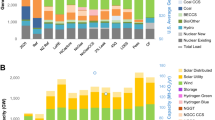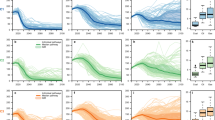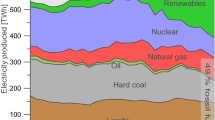Abstract
Over 100 countries pledged to reduce methane emissions by 30% by 2030 at COP26, but whether gas can serve as a bridge to lower-carbon options remains disputed. With an increasingly global supply chain, countries have different responsibilities in mitigation. We determine the global average of life cycle greenhouse gas emissions from the delivery of gas-fired electricity to be 645 gCO2e kWh−1 (334–1,389 gCO2e kWh−1), amounting to 3.6 GtCO2e yr−1 in 2017 (10% of energy-related emissions). Deploying mitigation options can reduce global emissions from gas-fired power by 71% with carbon capture and storage, methane abatement, and efficiency upgrades contributing 43%, 12% and 5%, respectively. Mitigation falls within national responsibilities, except an annual 20.5 MtCO2e of ocean transport emissions. For gas to truly be a bridge fuel, countries involved with the life cycle of gas-fired power need to deploy all mitigation options while balancing the risk of locking in carbon-intensive electricity.
This is a preview of subscription content, access via your institution
Access options
Access Nature and 54 other Nature Portfolio journals
Get Nature+, our best-value online-access subscription
$29.99 / 30 days
cancel any time
Subscribe to this journal
Receive 12 print issues and online access
$209.00 per year
only $17.42 per issue
Buy this article
- Purchase on Springer Link
- Instant access to full article PDF
Prices may be subject to local taxes which are calculated during checkout






Similar content being viewed by others
Data availability
All data are available by request from the corresponding author. Data inputs were sourced from IEA data that require a subscription. As a result, the full model and inputs will be distributed in line with subscriptions to inputs.
Code availability
Models will be provided upon request in line with data subscriptions to IEA data.
References
IPCC Climate Change 2021: The Physical Science Basis. Contribution of Working Group I to the Sixth Assessment Report of the Intergovernmental Panel on Climate Change (eds Masson-Delmotte, V. et al.) (Cambridge Univ. Press, 2021).
Bistline, J. E. & Blanford, G. J. The role of the power sector in net-zero energy systems. Energy Clim. Change 2, 100045 (2021).
Gürsan, C. & de Gooyert, V. The systemic impact of a transition fuel: does natural gas help or hinder the energy transition? Renew. Sustain. Energy Rev. 138, 110552 (2021).
The Role of Gas in Today’s Energy Transitions (International Energy Agency, 2019).
Jordaan, S. M. Wells to Wire. Springer Nature, Switzerland (2021).
IPCC Special Report on Global Warming of 1.5 °C (eds Masson-Delmotte, V. et al.) (Cambridge Univ. Press, 2018); https://doi.org/10.1017/9781009157940
World Energy Model (International Energy Agency, 2021); https://www.iea.org/reports/world-energy-model (2021)
Seto, K. C. et al. Carbon lock-in: types, causes, and policy implications. Annu. Rev. Environ. Resour. 41, 425–452 (2016).
Hayhoe, K., Kheshgi, H. S., Jain, A. K. & Wuebbles, D. J. Substitution of natural gas for coal: climatic effects of utility sector emissions. Clim. Change 54, 107–139 (2002).
Gilbert, A. Q. & Sovacool, B. K. Benchmarking natural gas and coal-fired electricity generation in the United States. Energy 134, 622–628 (2017).
Heath, G. A., O’Donoughue, P., Arent, D. J. & Bazilian, M. Harmonization of initial estimates of shale gas life cycle greenhouse gas emissions for electric power generation. Proc. Natl Acad. Sci. USA 111, 3167 (2014).
O'Donoughue, P. R., Heath, G. A., Dolan, S. L. & Vorum, M. Life cycle greenhouse gas emissions of electricity generated from conventionally produced natural gas: systematic review and harmonization. J. Ind. Ecol. 18, 125–144 (2014).
Trencher, G., Rinscheid, A., Duygan, M., Truong, N. & Asuka, J. Revisiting carbon lock-in in energy systems: explaining the perpetuation of coal power in Japan. Energy Res. Soc. Sci. 69, 101770 (2020).
Petherick, A. Gas or coal? Nat. Clim. Change 1, 392 (2011).
Alvarez, R. A., Pacala, S. W., Winebrake, J. J., Chameides, W. L. & Hamburg, S. P. Greater focus needed on methane leakage from natural gas infrastructure. Proc. Natl Acad. Sci. USA 109, 6435–6440 (2012).
Global Methane Pledge (2021); https://www.globalmethanepledge.org/
Zhang, X., Myhrvold, N. P., Hausfather, Z. & Caldeira, K. Climate benefits of natural gas as a bridge fuel and potential delay of near-zero energy systems. Appl. Energy 167, 317–322 (2016).
Rubin, E. S., Davison, J. E. & Herzog, H. J. The cost of CO2 capture and storage. Int. J. Greenh. Gas. Control 40, 378–400 (2015).
Ladage, S. et al. On the climate benefit of a coal-to-gas shift in Germany’s electric power sector. Sci. Rep. 11, 1–12 (2021).
Mac Kinnon, M. A., Brouwer, J. & Samuelsen, S. The role of natural gas and its infrastructure in mitigating greenhouse gas emissions, improving regional air quality, and renewable resource integration. Prog. Energy Combust. Sci. 64, 62–92 (2018).
Babaee, S. & Loughlin, D. H. Exploring the role of natural gas power plants with carbon capture and storage as a bridge to a low-carbon future. Clean. Technol. Environ. Policy 20, 379–391 (2018).
Surana, K. & Jordaan, S. M. The climate mitigation opportunity behind global power transmission and distribution. Nat. Clim. Change 9, 660–665 (2019).
Ometto, J.P. et al. Uncertainties in greenhouse gases inventories – expanding our perspective. In: Ometto, J.P. et al (eds) Uncertainties in Greenhouse Gas Inventories. Springer, Cham. https://doi.org/10.1007/978-3-319-15901-0_1 (2015).
Jonas, M. et al. Quantifying greenhouse gas emissions. Mitig. Adapt. Strat. Glob. Change 24, 839–852 (2019).
Kasumu, A. S., Li, V., Coleman, J. W., Liendo, J. & Jordaan, S. M. Country-level life cycle assessment of greenhouse gas emissions from liquefied natural gas trade for electricity generation. Environ. Sci. Technol. 52, 1735–1746 (2018).
Abrahams, L. S., Samaras, C., Griffin, W. M. & Matthews, H. S. Life cycle greenhouse gas emissions from US liquefied natural gas exports: implications for end uses. Environ. Sci. Technol. 49, 3237–3245 (2015).
Balcombe, P., Anderson, K., Speirs, J., Brandon, N. & Hawkes, A. The natural gas supply chain: the importance of methane and carbon dioxide emissions. ACS Sustain. Chem. Eng. 5, 3–20 (2017).
Tavakkoli, S., Feng, L., Miller, S. M. & Jordaan, S. M. Implications of generation efficiencies and supply chain leaks for the life cycle greenhouse gas emissions of natural gas-fired electricity in the United States. Environ. Sci. Technol. 56, 2540–2550 (2022).
Cooper, J., Balcombe, P. & Hawkes, A. The quantification of methane emissions and assessment of emissions data for the largest natural gas supply chains. J. Clean. Prod. 320, 128856 (2021).
Heitmann, N. & Khalilian, S. Accounting for carbon dioxide emissions from international shipping: burden sharing under different UNFCCC allocation options and regime scenarios. Mar. Policy 35, 682–691 (2011).
Roman-White, S. A. et al. LNG supply chains: a supplier-specific life-cycle assessment for improved emission accounting. ACS Sustain. Chem. Eng. 9, 10857–10867 (2021).
Full Lifecycle Emissions Intensity of Global Coal and Gas Supply for Power Generation (International Energy Agency, 2018).
World Energy Balances, 2020, IEA World Energy Statistics and Balances (database) (International Energy Agency, 2021).
Antmann, P. Reducing Technical and Non-technical Losses in the Power Sector (World Bank, 2009); https://openknowledge.worldbank.org/handle/10986/20786
Greenhouse Gas Emissions from Energy: Overview (International Energy Agency, 2021); https://www.iea.org/reports/greenhouse-gas-emissions-from-energy-overview
Davis, S. J. et al. Net-zero emissions energy systems. Science 360, eaas9793 (2018).
International Shipping (International Energy Agency, 2021); https://www.iea.org/reports/international-shipping
GE Global Power Plant Efficiency Analysis (General Electric, 2016).
Pospíšil, J. et al. Energy demand of liquefaction and regasification of natural gas and the potential of LNG for operative thermal energy storage. Renew. Sustain. Energy Rev. 99, 1–15 (2019).
Methane Tracker 2021 (International Energy Agency, 2021); https://www.iea.org/reports/methane-tracker-2021
CCUS in Clean Energy Transitions (International Energy Agency, 2020); https://www.iea.org/reports/ccus-in-clean-energy-transitions
IPCC Climate Change 2014: Synthesis Report (eds Core Writing Team, Pachauri, R. K. & Meyer, L.A.) (IPCC, 2014); https://www.ipcc.ch/pdf/assessment-report/ar5/syr/AR5_SYR_FINAL_SPM.pdf
Alvarez, R. A. et al. Assessment of methane emissions from the US oil and gas supply chain. Science 361, 186–188 (2018).
Chan, E. et al. Eight-year estimates of methane emissions from oil and gas operations in Western Canada are nearly twice those reported in inventories. Environ. Sci. Technol. 54, 14899–14909 (2020).
Matthews, H. D. et al. Opportunities and challenges in using remaining carbon budgets to guide climate policy. Nat. Geosci. 13, 769–779 (2020).
Riboldi, L. & Bolland, O. Overview on pressure swing adsorption (PSA) as CO2 capture technology: state-of-the-art, limits and potentials. Energy Procedia 114, 2390–2400 (2017).
Marx, J. et al. Environmental evaluation of CCS using life cycle assessment—a synthesis report. Energy Procedia 4, 2448–2456 (2011).
Power Generation in the Sustainable Development Scenario, 2000–2040 (International Energy Agency, 2020); https://www.iea.org/data-and-statistics/charts/power-generation-in-the-sustainable-development-scenario-2000-2040
Mac Dowell, N., Fennell, P. S., Shah, N. & Maitland, G. C. The role of CO2 capture and utilization in mitigating climate change. Nat. Clim. Change 7, 243–249 (2017).
Wang, J. et al. Large-scale controlled experiment demonstrates effectiveness of methane leak detection and repair programs at oil and gas facilities. Preprint at https://eartharxiv.org/repository/view/2935/ (2021).
Kemp, C. E. & Ravikumar, A. P. New technologies can cost effectively reduce oil and gas methane emissions, but policies will require careful design to establish mitigation equivalence. Environ. Sci. Technol. 55, 9140–9149 (2021).
Ravikumar, A. P. et al. Repeated leak detection and repair surveys reduce methane emissions over scale of years. Environ. Res. Lett. 15, 034029 (2020).
Erickson, P., Kartha, S., Lazarus, M. & Tempest, K. Assessing carbon lock-in. Environ. Res. Lett. 10, 084023 (2015).
Is Carbon Capture Too Expensive? (International Energy Agency, 2021); https://www.iea.org/commentaries/is-carbon-capture-too-expensive
Schmelz, W. J., Hochman, G. & Miller, K. G. Total cost of carbon capture and storage implemented at a regional scale: northeastern and midwestern United States. Interface Focus 10, 20190065 (2020).
Naims, H. Economics of carbon dioxide capture and utilization—a supply and demand perspective. Environ. Sci. Pollut. Res. 23, 22226–22241 (2016).
Net Zero by 2050 (International Energy Agency, 2021); https://www.iea.org/reports/net-zero-by-2050
Weber, C. L. & Clavin, C. Life cycle carbon footprint of shale gas: Review of evidence and implications. Environ. Sci. Technol. 46, 5688–5695 (2012).
Marchese, A. J. et al. Methane emissions from United States natural gas gathering and processing. Environ. Sci. Technol. 49, 10718–10727 (2015).
Weber, C. L., Jaramillo, P., Marriott, J. & Samaras, C. Life cycle assessment and grid electricity: what do we know and what can we know? Environ. Sci. Technol. 44, 1895–1901 (2010).
Omara, M. et al. Methane emissions from US low production oil and natural gas well sites. Nat. Commun. 13, 1–10 (2022).
Chen, Y. et al. Quantifying regional methane emissions in the new mexico permian basin with a comprehensive aerial survey. Environ. Sci. Technol. 56, 4317–4323 (2022).
Miller, S. M. et al. Anthropogenic emissions of methane in the United States. Proc. Natl Acad. Sci. USA 110, 20018–20022 (2013).
Miller, S. M. & Michalak, A. M. Constraining sector-specific CO2 and CH4 emissions in the US. Atmos. Chem. Phys. 17, 3963–3985 (2017).
Varon, D. J. et al. Satellite discovery of anomalously large methane point sources from oil/gas production. Geophys. Res. Lett. 46, 13507–13516 (2019).
Hu, H. et al. Toward global mapping of methane with TROPOMI: first results and intersatellite comparison to GOSAT. Geophys. Res. Lett. 45, 3682–3689 (2018).
Lauvaux, T. et al. Global assessment of oil and gas methane ultra-emitters. Science 375, 557–561 (2022).
Cellura, M., Cusenza, M. A. & Longo, S. Energy-related GHG emissions balances: IPCC versus LCA. Sci. Total Environ. 628, 1328–1339 (2018).
Volkart, K., Bauer, C. & Boulet, C. Life cycle assessment of carbon capture and storage in power generation and industry in Europe. Int. J. Greenhouse Gas Control 16, 91–106.
Lacy, R. et al. Life-cycle GHG assessment of carbon capture, use and geological storage (CCUS) for linked primary energy and electricity production. Int. J. Greenh. Gas. Control 42, 165–174 (2015).
Singh, B., Strømman, A. H. & Hertwich, E. Life cycle assessment of natural gas combined cycle power plant with post-combustion carbon capture, transport and storage. Int. J. Greenh. Gas. Control 5, 457–466 (2011).
Hertwich, E. G. et al. Integrated life-cycle assessment of electricity-supply scenarios confirms global environmental benefit of low-carbon technologies. Proc. Natl Acad. Sci. USA 112, 6277–6282 (2015).
Lin, W., Zhang, N. & Gu, A. LNG (liquefied natural gas): a necessary part in China’s future energy infrastructure. Energy 35, 4383–4391 (2010).
British Petroleum. BP Statistical Review of World Energy2021; https://www.bp.com/en/global/corporate/energy-economics/statistical-review-of-world-energy.html
Ritchie, H., Roser, M., & Rosado, P. Energy (2020); https://ourworldindata.org/energy
International Energy Data (US Energy Information Administration, 2021); https://www.eia.gov/international/overview/world
Global Non-CO2 Greenhouse Gas Emission Projections & Marginal Abatement Cost Analysis (US Environmental Protection Agency, 2019).
Aspen Plus, Aspen Properties v.10, Aspen Process Economic Analyzer v.10 (Aspentech, 2017).
Koornneef, J., van Keulen, T., Faaij, A. & Turkenburg, W. Life cycle assessment of a pulverized coal power plant with post-combustion capture, transport and storage of CO2. Int. J. Greenh. Gas. Control 2, 448–467 (2008).
Acknowledgements
S.M.J. and S.M.M. were supported by a Johns Hopkins Discovery Award. S.M.J. was supported by a Johns Hopkins Catalyst Award. D.N. was supported by NSF grant 2017789 and the Wilson E. Scott Institute for Energy Innovation where she is an energy fellow.
Author information
Authors and Affiliations
Contributions
S.M.J. conceived and supervised the study, gathered preliminary data, conducted preliminary analysis, designed the formal analysis and investigation, developed the methodology, provided resources, and contributed to writing the original draft and to reviewing and editing. A.W.R. curated the full dataset, completed the formal analysis and investigation, developed the methodology, contributed resources, developed data visualizations, and contributed to writing the original draft and to reviewing and editing. K.S. provided conceptual feedback throughout the analysis, contributed data on power T&D losses, and contributed to the writing through reviewing and editing. D.N. provided conceptual feedback throughout the analysis, contributed data and methods on power T&D losses, and contributed to the writing through reviewing and editing. S.M.M. provided conceptual feedback, data critique, and contributed to the writing through reviewing and editing. A.P.R. provided conceptual feedback, contributed preliminary data on methane emissions from natural-gas productions systems, and contributed to the writing through reviewing and editing.
Corresponding author
Ethics declarations
Competing interests
A.P.R. has current research support from natural-gas producers and Environmental Defense Fund and is currently serving on the US Department of Transportation’s Pipeline Advisory Committee. The remaining authors declare no competing interests. K.S. is an employee of the company IST cube, which invests in science- and technology-driven start-ups, all unrelated to the present paper.
Peer review
Peer review information
Nature Climate Change thanks Jasmin Cooper, Thomas Gibon and Xiaojin Zhang for their contribution to the peer review of this work.
Additional information
Publisher’s note Springer Nature remains neutral with regard to jurisdictional claims in published maps and institutional affiliations.
Extended data
Extended Data Fig. 1 The natural gas supply chain evaluated in this study.
This supply chain encompasses the life cycle stages, and resulting emissions, of natural gas-fired electricity generation from extraction to end-user consumption. At all stages, energy consumption leads to direct CO2 emissions. The stages that lead to upstream and downstream methane emissions are explicitly noted.
Extended Data Fig. 2
Overview of the data inputs used in the model development.
Extended Data Fig 3 Comparison of our distribution of calculated country-level life cycle emission intensities for natural gas-fired power generation compared to the distribution provided by the IEA at facility-level50.
(a) compares the distributions with electricity T&D losses included, showing an overprediction in values by our calculated results. However, (b) compares the distributions with electricity T&D losses excluded, showing better agreement between distributions. The distributions begin to deviate at percentile 60, before deviating significantly near percentile 90.
Extended Data Fig. 4 Life cycle greenhouse gas emissions of countries that have gas-fired power, if CCS were to be equipped, in grams of CO2-equivalent per kilowatt-hour (CO2eq/kWh).
(a) represents the spatial distribution of life cycle emissions for the 108 countries with gas-fired power if CCS were to be equipped. (b) compares the emission intensity of gas-fired power generation for each country with and without CCS using the same data as panel (a) and Fig. 2(a) from the main text, with specific countries highlighted for comparison. (c) Represents the results for the cross-section of the world’s 10 largest natural gas producers and consumers. Basemap copyright attributed to Microsoft Corporation, OpenStreetMap, TomTom and others.
Extended Data Fig. 5 Methane leakage for upstream and downstream sources reported by different sources and compared across countries. The range from Balcombe et al.1 is represented by the dashed lines.
(a) presents the upstream comparison for the UNFCCC and the EPA downstream values. (b) presents the downstream comparison for the UNFCCC and the EPA downstream values. (c) includes a smaller subset for available upstream sources in the IEA, UNFCCC and EPA. (d) includes a smaller subset for available downstream sources in the IEA, UNFCCC and EPA.
Supplementary information
Supplementary Information
Supplementary Discussion and Tables 1–3.
Supplementary Data 1
Life cycle emissions results, with and without combined heat and power; Methane emissions adjustments.
Rights and permissions
Springer Nature or its licensor (e.g. a society or other partner) holds exclusive rights to this article under a publishing agreement with the author(s) or other rightsholder(s); author self-archiving of the accepted manuscript version of this article is solely governed by the terms of such publishing agreement and applicable law.
About this article
Cite this article
Jordaan, S.M., Ruttinger, A.W., Surana, K. et al. Global mitigation opportunities for the life cycle of natural gas-fired power. Nat. Clim. Chang. 12, 1059–1067 (2022). https://doi.org/10.1038/s41558-022-01503-5
Received:
Accepted:
Published:
Issue Date:
DOI: https://doi.org/10.1038/s41558-022-01503-5
This article is cited by
-
Air pollution disparities and equality assessments of US national decarbonization strategies
Nature Communications (2022)
-
Cutting emissions outside borders
Nature Climate Change (2022)



